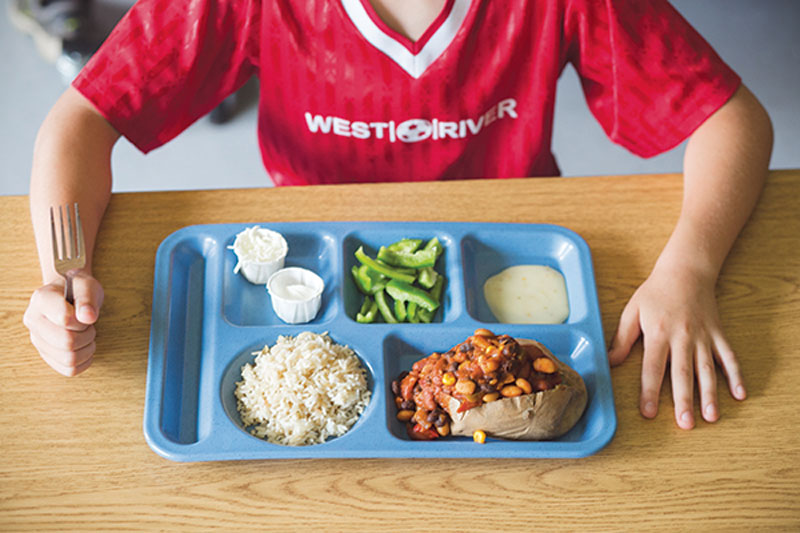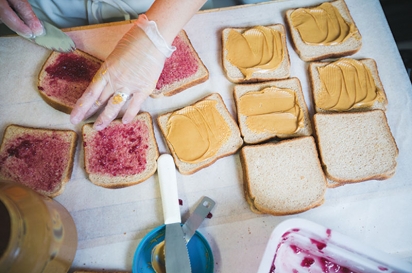Dishing Up a Revolution in the School Cafeteria
It’s 11:10 in the morning when the first through third graders burst into the cafeteria, chattering as they grab their trays and follow the familiar pattern: First through the line for a hot entrée, then to the salad bar that’s just their height to select from an array of freshly cut-up fruits and vegetables, pick up some milk and settle down for a 25-minute break in their day.
No one has told these 60 or so elementary school children that they are participating in a global food revolution but they are. One lunch period at a time.
The kitchen at Flood Brook Elementary School in Londonderry, Vermont, is slightly wider than a school bus. There are prep tables, convection ovens, mixers, refrigerators, sinks, dishwashers and a grand old Garland eight-burner gas stove complete with griddle. For 180 days a year this is Kelly Foster’s sphere of influence over the food that students, faculty and staff will eat. It’s her goal to give them the freshest, most nutritious and delicious menus she can produce on a chronically tight budget.
The balancing act happens every day in school cafeterias across the country, thanks to reams of regulations, numerous logistical issues and the pressure of keeping student interest, in addition to the usual food preparation decisions found in every professional kitchen.
After completing three and half years of culinary and nutrition training in New York City, Kelly had the cooking chops and kitchen management skills to work in any number of places. However, she chose to return to her home in Vermont in 2009 ready to take on the challenge of putting her beliefs about the importance of nutrition and fresh food to the test. Her laboratory is the cafeteria of this small school where 280 students and a dozen teachers and staff members count on her to satisfy their hunger as well as their nutritional needs.
Following the guidelines for child nutrition from the USDA, she must make certain that every day’s menu includes whole grains, protein (or protein equivalent), fruits and vegetables, and milk. There’s a hot entrée every day, a generous salad bar and peanut butter and cheeses to provide an alternative meal option. Her goal is to gradually introduce new menu options and try to offer more variety for the K–8 palate.
“When I started there was a good program in place but the menus weren’t very involved,” she said as I stood in the kitchen during pre-lunch prep with Foster and her hard-working staff of one, Heather Borhek. The demand for qualified professionals to oversee school lunch programs is growing nationwide as the spotlight moves to food in institutions. Grounded in her training in nutrition and recent research, she began by getting rid of margarine, the cans of cheddar cheese sauce and mashed potatoes, and pre-cooked items like chicken nuggets. She started cooking as much as she could from scratch.
“There is a certain amount of risk we take on when cooking from scratch since food safety is critical,” she explained. “Managing a larger inventory of raw ingredients and calculating serving sizes and recipe yields also adds pressure to this approach.”
Brunch for Lunch was a very popular menu staple when she arrived. She worked with it, replacing pre-cooked frozen egg patties with fresh eggs, heat-and-serve frozen pancakes with gallons of homemade batter, and artificial syrup with Sugarbob’s real maple syrup from the nearby town of Landgrove.
“If you start with raw materials then you are cranking up the labor element, but the quality and nutrition of the food definitely increases. Usually this way is also more cost-effective.”
What can we be doing better is the question she continues to ask four years into her school food challenge. Locally sourced food from sustainable sources was certainly high on her list from the start. Kelly soon found Steve and Esta Morris of Ephraim Farm in Springfield, Vermont, who were willing to work with her to provide grass-fed beef.
“Steve was excited to work with us and supply healthier beef for the kids’ lunches so he gave us a competitive price,” she said. Locally sourced beef proved to be affordable but choosing organic produce is much more challenging.
She doesn’t expect all local producers to cut her a deal, and this is where the tension comes in between the desire to have more nutritious food and the financial reality of a budget.
“This is our great challenge and also part of the joy,” she said. “I do like working with budgets as much as I like cooking for the kids. In a school you can’t raise the prices of the menu items on any given day so the purchasing and planning have to be done very carefully.”
Ordering food becomes a daily predicament. “I’m not always certain which direction to go in: trimming food expenses or spending a little more on the local economy and getting higher-quality, organic foods.
“If we opt to make the more cost-conscious choice, we add labor to increase the quality and value of the food item. For example, we offer mostly conventional produce but the fruit and veggies are cut up fresh daily for the salad bar, or to make hot entrée items. Beans are not organic or local, but I’ll try to buy them dried and not canned to maximize their nutritional value. Most of our cheese comes from the government commodity program, but it’s still real cheese and it’s used as a building block for freshly cooked entrées such as quesadillas, tacos and macaroni and cheese. Chicken and pork are not sourced locally, but we purchase them raw and ‘unadulterated.’”
A mandatory component of her day is record keeping, which must be meticulous. After every lunch she and her staff must do a count of how much food they went through—every single item.
“We have to balance the time taking notes and being in compliance with our time spent preparing and serving meals,” she said.
Kelly is always looking for ways to increase the quality of the food within the constraints that come with the job. She sees real progress in changes made to federal guidelines in the USDA commodity food catalog offering schools across the country healthier products. Every school is given a certain allotment of federal dollars depending on the number of students. With recent changes in place she can now purchase in advance and substitute items rather than be forced to reject some items.
“We have more control now over how we allocate the money for food purchases.” This means more possibilities for local purchases but she still has to weigh the advantages and choose produce that is more likely to last a while, such as organic carrots.
In the future, she is especially looking forward to working more with the nearby Windham Farm and Food Network, a collaboration of local farms that supplies fresh food to over 30 institutional buyers in the Windham County area.
“There are many school cooks in Vermont creating healthy and delicious meals for kids. We have a new cookbook because of them!” Published in 2013, the New School Cuisine: Nutritious and Seasonal Recipes for School Cooks by School Cooks features local seasonal recipes developed by Vermont school nutrition professionals with support from the New England Culinary Institute.
There are more and more schools that have impressive school gardens and valuable relationships with local farmers, which also creates exciting learning opportunities in the classroom.
“The kids are benefitting on a lot of levels.”






